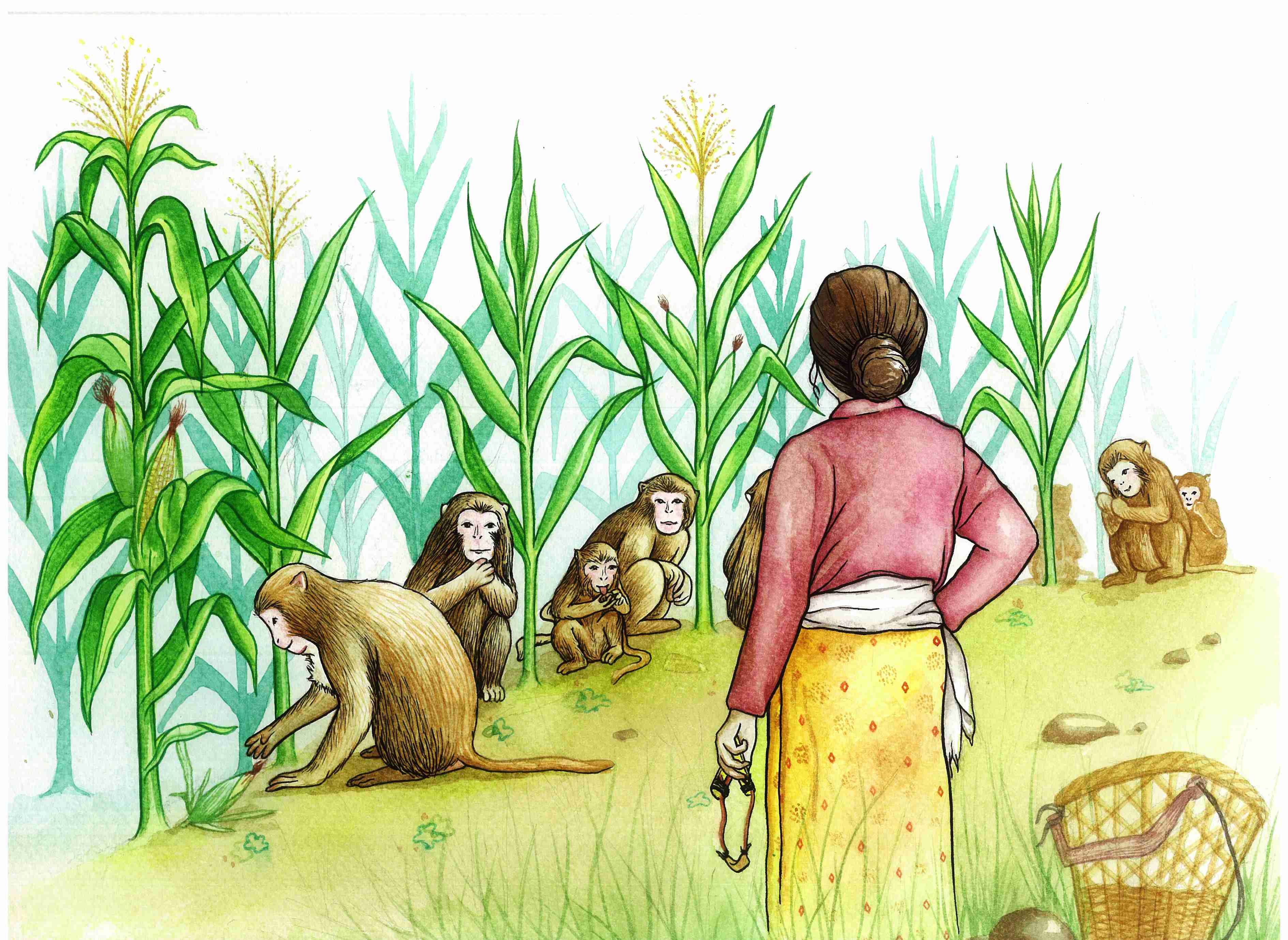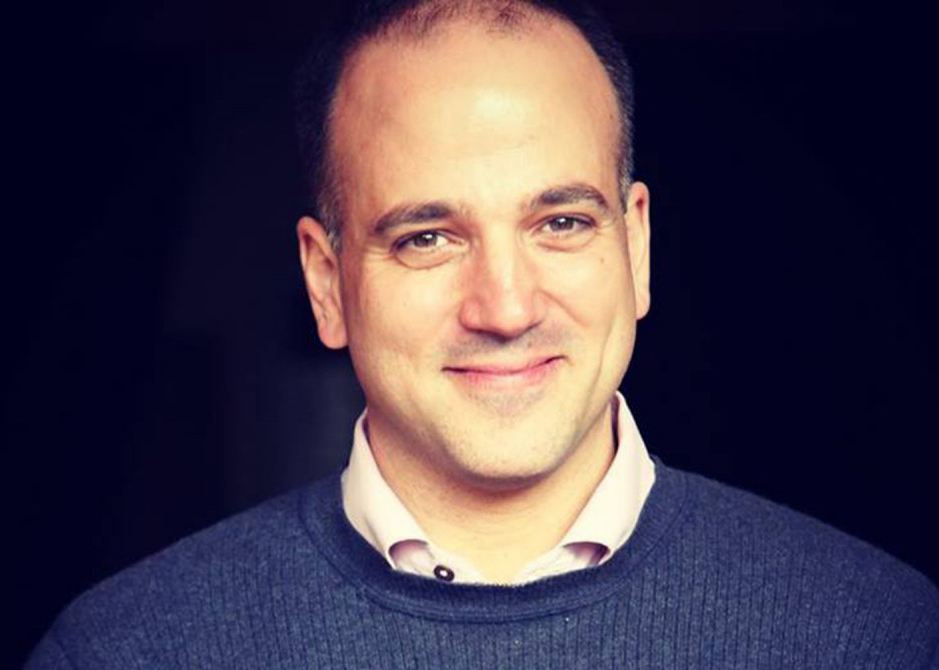Investigations
How a conversation around the length of one’s hair exposed the toxic environment of a Kathmandu school
Considered one of the most prestigious schools in the country, St. Mary’s, former and current students say, reeks of toxicity, with many having had to go through years of harassment, queerphobia, and public humiliation.
Ankit Khadgi & Samiksha Baral
Megha distinctly remembers that day. It was scorching hot. She was a fifth-grade student, and her singing class was about to start. It was the last class of the day and almost 100 students of two sections were to attend it.
Before entering the packed classroom, to cool themselves, she, along with her friends, washed their faces with cold water. What followed would leave her with a traumatic experience–one that still haunts her more than nine years later.
“As I had washed my face, there were a few drops of water on my shirt. The singing teacher called me in front of him and told me that I shouldn’t have washed my face with cold water as I might catch a cold,” said the girl, who the Post is identifying as Megha given the sensitivity of the matter. (In this article, we have identified an ex-St. Mary's student, who did not want to be named, as Megha. The real name of the ex-student we spoke to is not Megha. Any resemblance to actual person(s) is purely a coincidence.) “And then in front of everyone, he suddenly put his hands inside my shirt pretending to wipe away the water. He then took his hands inside my sando, and molested me in front of everyone,” added Megha, who studied at the Kathmandu-based St. Mary’s School for 10 years.
In the past few days, many former and present students of St. Mary’s School have shared the disturbing experiences they have experienced in the institution. Megha is one among them.
St. Mary’s School, also known as SMS, is one of the most prestigious all-girls schools in the country and has over the years earned a reputation for delivering high-quality education at lower fees than most private schools in Nepal. The convent school was formally established in 1955, making it one of the oldest private schools for girls in Nepal. And in its six decades of establishment, the Roman Catholic institution, which runs under the management of the Sisters of the Congregation of Jesus, which was founded by Mary Ward in the 17th century, has also opened several branches across the country, including Gorkha, Pokhara and Biratnagar.
Behind this shiny facade, however, according to the many current and former students the Post spoke to, the institution reeks of toxicity, so much so that that institution has affected many of them psychologically.
“St. Mary’s is a toxic institution. It has affected me so much that even though I live nearby the school, whenever I pass by it, I am scared to even look at it. When I was studying there I even missed a lot of my classes during my final years of schooling, as it was mental torture for me to visit the school,” says another former student, who studied at the school for more than 10 years, in a phone interview.
According to the students, one of the toxic cultures that exist in the school is its inability to listen and empathise with them. The teachers and the sisters are so indifferent that they don’t care about what the students are going through, they say.
When Megha had complained about the harassment she had faced, during her last years in the school, no action was taken against the teacher, she says.
“At the time the incident took place I was very young, I couldn’t even process what had happened. I couldn’t sleep for two weeks. However, during my final years, I decided to tell the school [the ex-principal] about how he [the singing teacher] had molested me,” says Megha. “I found out that he used to harass other students too; whenever any girl requested to go to the toilet or they wanted to go to the infirmary, he would touch them inappropriately, telling them that he is a doctor and he can fix their pain.”
And Megha is not the only student to be harassed by the said teacher. Many other former students the Post spoke to said how the teacher would make them kiss him on his cheeks and sit on his lap. The students say that the teacher also used to touch their private areas. The teacher’s predatory behaviour is an open secret in the school, yet he continues to teach at the institution.
How it all started
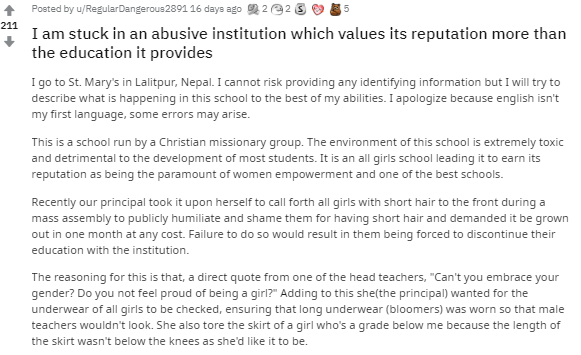
A flurry of posts by current and former students on social media platforms like Reddit, Instagram, Twitter, and Facebook started the conversation around St. Mary’s School. The posts were prompted by a recent incident at the school regarding its students’ hair length.
On March 19, without any prior announcement, students with short hair were called in front of the school’s morning assembly and shamed for their hair length, says a current student who was present in the assembly.
“Our school was always fine with short hair. But without any announcement they started calling out girls from the assembly who had short hair and started humiliating them,” she says.
Students at St. Mary’s are familiar with the school’s many draconian rules--from the monitoring of the length of the skirt of the students to the regular checking of their undergarments, to ensure that all of them are wearing bloomers--but this new rule that prevented them from having short hair was news to them.
And girls weren’t only subjected to humiliation for their choice of hair length. A senior teacher went so far as to ask girls with short hair whether they were proud of their gender or not, says the student.
“The length of our hair was associated with our femininity,” she says. And that did not sit well with the students.
Sister Mariette, the principal of the school, however, says that the rule for not having short hair has always existed in the institution. Although there’s no mention of the rule that students must have long hair in the school's rule book or on its website, the principal says that students of the school are always supposed to have hair below the shoulders.
“Not every rule can be written or printed. Some rules are verbal. If it’s for medical reasons, girls can have short hair--but only after they submit an application to us,” she says.
In the conversation she had with the Post, she says that no girls were humiliated in the assembly. They were just informed that they should grow their hair, she says.
But the accounts of students differ, as many current students told the Post that girls with short hair were misbehaved with and humiliated in the assembly. School authorities even told them to grow their hair within two weeks at any cost.
“We are always told that the way we wear our skirts or the way we style our hair has an ‘impact’ on how we are treated by people and society,” says a current student, in an email interview. “Studying at St. Mary's is like living in a cage that has bars that are just too rigid.”
Done with such archaic rules and regulations of the school, which in the name of ‘protection’ were in fact placed for policing their behaviour, the students felt the need to have a discussion.
At first, the students say they made efforts to talk with teachers, sisters and the principal of the institution to solve such problems internally. But like their alumni (dijus, who they call fondly), who in the past also had made attempts to talk with the school authorities, none of their efforts was appreciated by the institution, as they always turned a deaf ear to their problems.
“We are always told not to question our school and teachers. There’s no room for feedback. Even when parents try to question the rules, they are told that gates of schools are always open and their daughters can leave the school if they don't like the rules of the school,” says a current student, in a Zoom interview.
To show the authorities that what the school was enforcing was problematic at its core, students decided to take to social media to amplify their voices, says one of the students, who shared her experiences on a social media platform.
On March 21, a post was published on a platform called NEB Result & News on Facebook about the imposition of the short hair rule and how the girls with short hair were forced to grow their hair. The post detailed how the school authorities told the students to leave the school if they were unable to grow their hair in two weeks.
Then on March 23, on Reddit, a current student came forward to share her story. It was followed by another post on March 28. Since then, numerous present and former students have spoken about their experiences, with many hoping that school authorities will try to amend their behaviour towards them.

The victim-blaming culture
Among the many problems St. Mary's is currently grappling with, one concerning issue is victim-blaming, say the students. The students are time and again reminded that it’s their duty to ‘protect' themselves from ‘unwanted’ attention.
From the length of the skirt to how a woman should sit or behave, the students, who are on the cusp of adulthood, are repeatedly told that it’s “a woman's" action that is responsible for anything that happens to her in the institution by the teachers.
“The reasoning the school gives for making us wear bloomers is that they believe that it will ‘protect’ us from attracting unwanted attention of male teachers of the school,” says a student, over a Zoom call. “Time and again, we are taught that our body is our ‘temple'. We should ‘honour’ it. We should ‘protect’ it. Even if by mistake the buttons of our shirts are open, the school authorities say that we are trying to expose ourselves. They always try to put explicit connotations to our behaviour.”
Many students also say that the school runs on outdated gender norms, and those girls who do not adhere to these norms are called ‘indecent’.
“They picture a Marian to be this 'ideal' woman who wants a husband and children or a woman who has given up her whole life for the service of God. And that is by no means a bad choice. But not everyone's the same and they have failed to understand that. We all are different,” says a student, who’s currently studying at the institution.
“I remember one incident when I was sitting crossed-leg. A female teacher came and yelled at me. She told me that by sitting like this, I was inviting problems and was calling for the attention of male teachers,” says Megha.
The Post also found a clip of a video recording of a Zoom class shared by a student, where a teacher is telling secondary level students about how exposing oneself by wearing short clothes is something that shouldn’t be encouraged.
“Little we do know children... beauty lies in covering not in the opening (wearing short clothes). When you go outside in such ‘indecent’ clothing, compliments and appreciation will come. But along with it, what would also come is negative comments and criticism, and eve-teasing by men,” says the teacher to the students, implying that it’s because of how a girl dresses that they can be harassed or teased by men on the streets.
Likewise, even when students complained of incidents of harassment they were subjected to by male teachers, students say that rather than looking into the issue with sensitivity, students were questioned first and their behaviour was policed by the school authorities.
“Whenever students complain about a teacher’s predatory behaviour, the school always tries to be defensive by saying that the teacher is not like that. I remember that there was a teacher against whom no action was taken even though many students complained about his behaviour. It took a complaint from a guardian to finally expel him from the school,” says Megha.
Sister Mariette denies such allegations. She says that the school authorities have always taken such issues seriously and they have always been helpful to students if such cases arrive.
There is some truth to her claim. A former student told the Post that the school did take action against a male teacher who used to harass students a few years back.
“Almost two dozens of us had complained against this pedophilic teacher who harassed the girls. Although many teachers were in denial and told us to rethink our decisions, Sister Mariette was on our side. She was supportive. The teacher was then expelled from the school,” says a former student.
But not every case has been addressed this way.
In 2016, Radha (name changed), who was in the final years of her higher education, informed a teacher about the predatory behaviour of a teacher, the same one who had harassed Megha.“After we took a session on sexual harassment, my friend and I started discussing with other friends about the behaviour of the teacher. Some could recall, some couldn’t, but we came to realise that he had harassed a few of us,” says Radha, who studied at the institution for more than 10 years, over a phone call. “We were terrified because he was still teaching. And out of sheer concern for our juniors, we decided to talk with a teacher."
But the teacher, who taught Value Education, rather than helping her and her friends, told her to not speak about this issue further, as the male teacher had apologised for his behaviour.
“She said he [the teacher] cried and admitted that he had harassed us but he had not done it in years and he took God's name. She told us that the conversation had to be stopped there as the ‘sir’ was also a ‘good musician’ and to take the matter forward would ruin his reputation,” says Radha, whose real name the Post is not using at her request.
“We were taken aback by what she said to us. The school rather than filing a legal case against him or firing him was concerned about his reputation and not our safety,” she said.
A queerphobic institution?
Many students say that the teachers and sisters often try to inject queerphobia in the classrooms, deeming homosexuality a disease. According to current students, there is no room for acceptance for queer identities in the school; in fact, most teachers frequently try to pass on values like that one should feel guilty and ashamed if they embrace queer identities.
“Without any context, we are told again and again that homosexual attraction is a sin. They are extremely disgusted by queers identities and call queer people someone who has a mental illness,” says a student.
In an interview with The Record, Sister Mariette had even gone on record and said that "homosexuality is a sin".
Students say the institution holds its beliefs about queer identities so strongly that they don't even let girls hold hands or go to the toilet in each other’s company, they say.
“As a new rule, we were recently told not to hold hands, which to be honest is absurd,” says a current student.
A student who identified as queer told The Record that she feels discouraged from expressing her identity because of the constant queerphobic comments she hears on the school premises from the teachers.
Likewise, a former student also recalls how she and her friend were sent to the principal's room just because they were holding hands, she says.
“I was in grade six. A friend of mine held my hand and she was telling me how soft they were. Our teachers saw us and we were taken to the principal's office immediately,” she says. “We had no clue what wrong we had done. However, since she was the one who held my hands I was told that I could leave. Later I found out that they thought that we could be lesbians, and my friend was even yelled at and asked if she was one.”
When asked if such kind of queerphobic behaviour and attitude existed in the institution, Sister Mariette denied the allegations. “No one has ever been expelled for being homosexual. Neither have we taught anything to the students that promote such homophobic behaviour nor we stop girls from holding hands or going to the toilet in each other’s company,” she said.
The problem is not limited to Kathmandu
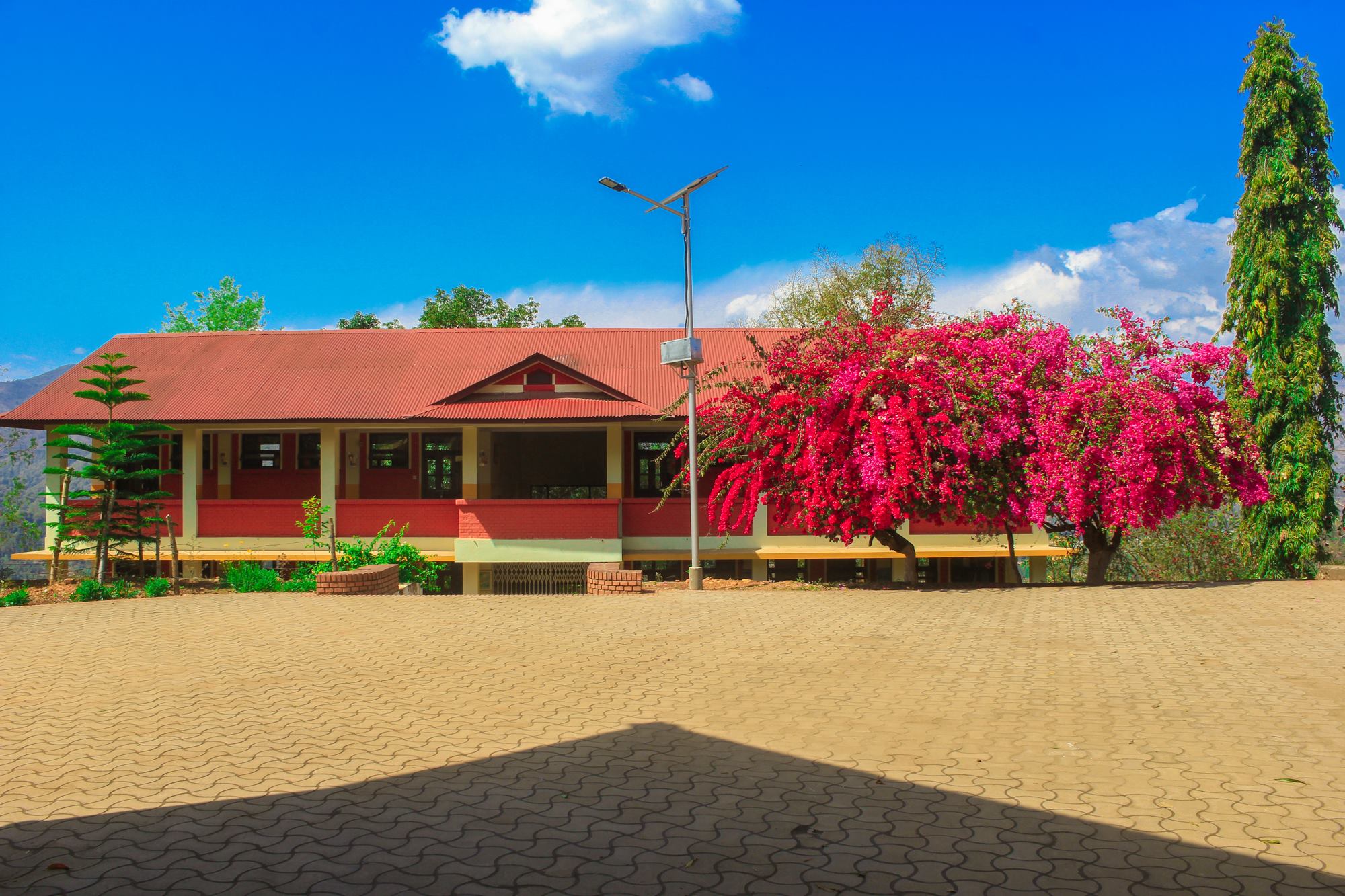
These troubling issues are not limited to the Kathmandu-based institution. The Post has discovered similar experiences of girls in different branches of St. Mary's across the country.
Sangita, a former student of St. Mary’s High School, Gorkha, had similar experiences when she was 15.
In 2012, when she was a ninth-grader, Sangita, who wanted a pseudonym instead of her real name, had to go through an experience that still haunts her.
“At a time when we were just starting to develop sexually, physically and mentally, checking our undergarments in front of everyone was a demeaning act of public shaming,” says Sangita.
Back then, she felt she had no choice but to adhere to the rules of the school. Now, she is happy that other girls have started speaking out.
“I am glad that girls are finally speaking up, something which we couldn't do in our time,” Sangita, who is currently studying in Kathmandu, told the Post this week.
A teaching-learning environment should free pupils of centuries-old patriarchal beliefs instead of further imprisoning them. But when the seeds of toxicity are sown at an early age, especially in schools, where they should actually teach and guide them to resist gender roles that society has set, even parents fear sending their children to school.
“I always wanted my children to take a stand against unfair treatment,” said a parent. “But the recent incidents of seeing girls speaking up on social media, I feel bad how institutions like St. Mary’s have been treating students on their premises that they even fear to share such issues with school management.”
Srija (name changed) from Biratnagar’s St. Mary's School says though she is not aware of incidents like harassment but she thinks many rules are still made to remind them of their gender roles.
"We are not allowed to cut our hair short and it's compulsory that we are made to wear my hair in two plaits," said Srija. “Reading all these news about how sisters from the valley are treated, I am happy now that the students are speaking, because such acts towards students must be stopped."
The psychological impact on the students
For Megha, who spoke to the Post over the phone, even though she has a soft corner for the institution, as she has spent almost her whole childhood there, she still feels anxious whenever she hears the name of the school.
“I still feel uncomfortable whenever people talk about the school because of whatever I had to go through when I studied there,” says Megha.
Likewise, many former students have shared their experiences on Reddit, about how the school mentally affected them, so much so that they have made suicidal attempts.
According to Karuna Kunwar, senior psychologist at the Centre for Mental Health and Counselling, Nepal, a toxic school culture can severely impact the mental health of students.
“From self-confidence issues to low self-esteem to even having suicidal feelings, if a student is studying in a toxic institution, there can be a long-term impact on their psychological well-being,” says Kunwar.
But that’s not the only harm a toxic school culture can lead to. Kunwar says that in such schools, where toxic culture is normalised, there will be a promotion of toxic and problematic values among the students as well who in future will also behave in the same toxic way with others.
“Teachers are the first role models of students and it's a school where a person grows and spends their childhood. That’s why it's important to make school free from any toxicity, as whatever they will learn in the school becomes their belief, their inner voice, which they will practise and preach in future as well,” says Kunwar.
And that’s why many current students say that they also face various problems like bullying from their peers as well in the school, as, for them, the institution has created a distorted sense of reality.
“Most of the students widely adopt the same mentality that the school believes in. And this is why I have to deal with many comments, which mostly stem out from the toxic things we are taught, that are passed on to me by my peers,” says a current student. “St. Mary’s has mentally impacted me. It’s extremely disturbing to return to the institution, every day."
Has St Mary’s lent an ear to students?
Although Sister Mariette said that her office has always been open for students, both current and former students, if they ever want to talk and share their experiences, many instances show that St. Mary’s isn't welcoming enough when it comes to criticism or handling students’ concerns.
Last year in July, inspired by various articles that were written by former students of various schools about the problematic beliefs that they tolerated, Aakriti Ghimire, a former student of St. Mary’s decided to bring forth her experiences and also start a conversation about the school and its rules.
“I wasn’t expecting any big thing to happen. I just wanted to start the conversation around the school, as we can’t sugarcoat our past memories,” she says. Through Instagram, she started collecting responses of former students, who shared their experiences of body-shaming, colourism, body policing, and period shaming.
While she was able to collect more than 80 responses in less than a week, she received a call from Nepal Police’s Cyber Crime, who informed her that a complaint had been filed against her by the school.
“I was told I was defaming St. Mary’s. But all I was doing was trying to spur a conversation,” says Ghimire in a phone interview.
She was then forced to make a public apology, which had to be approved by the institution. The institution did not have a look at any of the responses Ghimire had accumulated.
“They said that if I had any problem, I should directly come to them, which also goes for others,” says Ghimire, who was forced to take her post down and even threatened with legal action, just for trying to start a conversation in a digital space.
How did the school react?
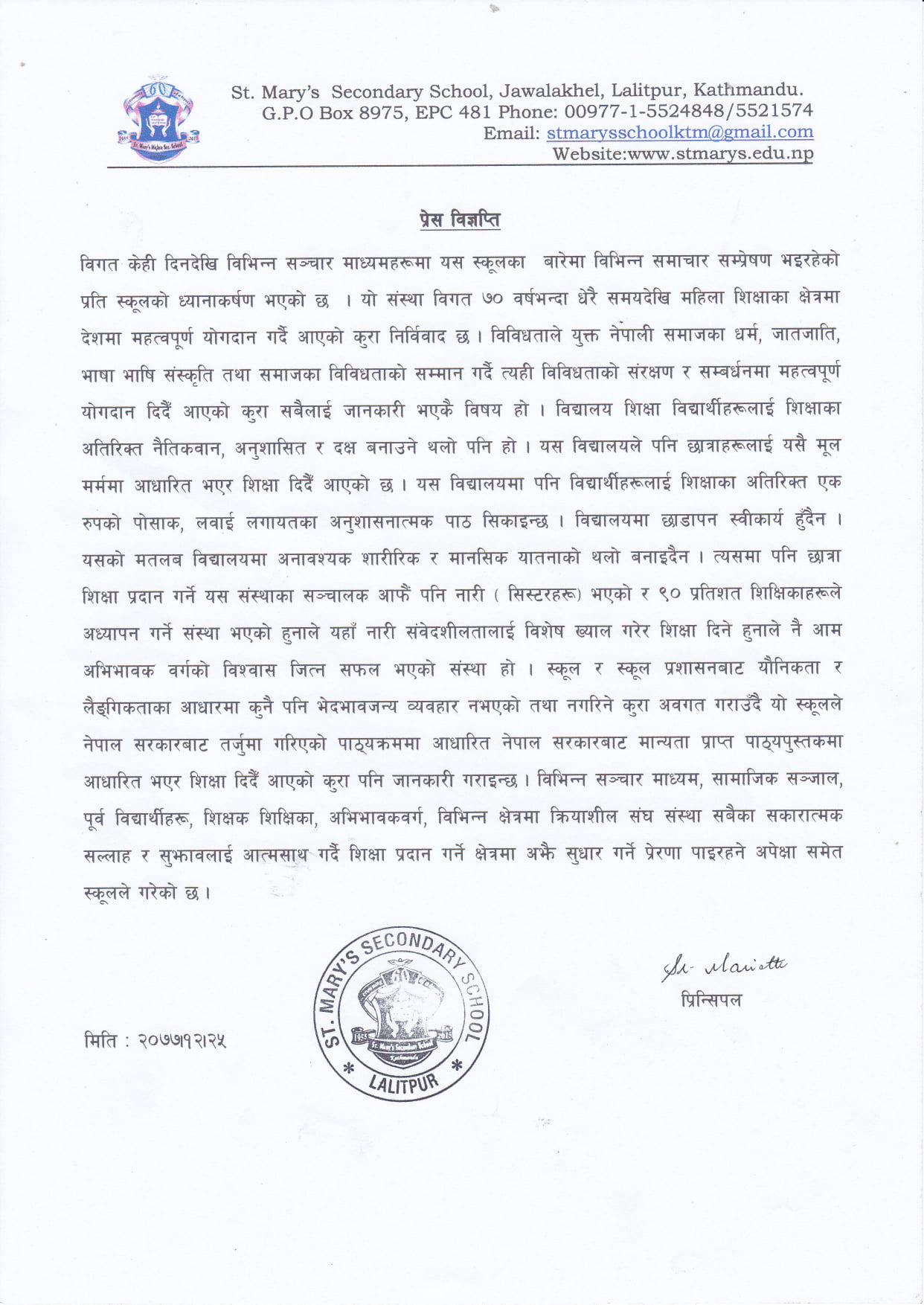
On April 7, the school released a press statement, briefing the recent incidents and the allegations made by current and former students against the school. But the school did not mention whether they were going to investigate any of the issues that surfaced or address the concerns of students.
In a conversation with the Post, Sister Mariette said the school would make some changes. “There will be certain awareness programmes that will be conducted in school for teachers,” she says.
But when asked what those programmes will be, she did not provide direct answers. However, she was firm in her stand regarding the investigation of the accusations. “The concerns of those students who come in direct touch with the school administration will be addressed and investigated,” she says.
“Making things public through social media; is it the right medium? The school is always open for conversation and there are counsellors, teachers, principal and even the management, who are ready to help. But we can only help the students, who come through the right medium of talking to us first, rather than posting on social media,” says Sister Mariette, who calls the allegations made by the students on social media an act of defaming the institution.
“This school has 2,500 students in total. Whoever has talked or said things about the institution can’t represent the experience of all students,” she adds.
But it’s not that students have not made any effort in talking directly with the teachers. “There’s no safe space in school that allows students to confide with teachers and the administration. Even if we speak, the teachers never listen and for years we have to carry the baggage. We tried to speak, but the school didn’t listen. That’s why he had to go to the internet to speak,” says a former student, who spoke against the toxicity of the institution.
Meanwhile, a few former students on social media have also come in support of the institution, calling that the rules are justified.
Although the Association of St. Mary’s Alumnae Nepal (AASMAN), an association of former students, hasn’t said or done anything, on April 10, a group of young alumnus, through their initiative ‘About Time’, conducted a Zoom meeting in order to address the issues and to help the students get a safer environment at school.
“We are not doing this to defame the school or the teachers. We just want to find a way that can solve and address the concerns of the students,” said one of the members of the initiative.
For students, especially the ones who are still affiliated with the school, the cost of speaking is severe, because if the school finds their real identity, they are bound to get expelled, they say.
“The teachers and the school authorities rather than investing their energy in finding what is wrong with the school are concerned about who are the ones who spoke against the institution. They are even interviewing school captains with the hope that they can find those who spoke against them,” says a current student.
But speaking out this way--knowing the consequences--was something they felt they had to do. They say that they are speaking not for them, but for the young girls who are studying and will study at the institution.
“Everybody needs to know about the toxic environment of St. Mary’s. We have suffered enough, but we won’t let the young budding leaders of tomorrow suffer,” says a current student.




 18.37°C Kathmandu
18.37°C Kathmandu

